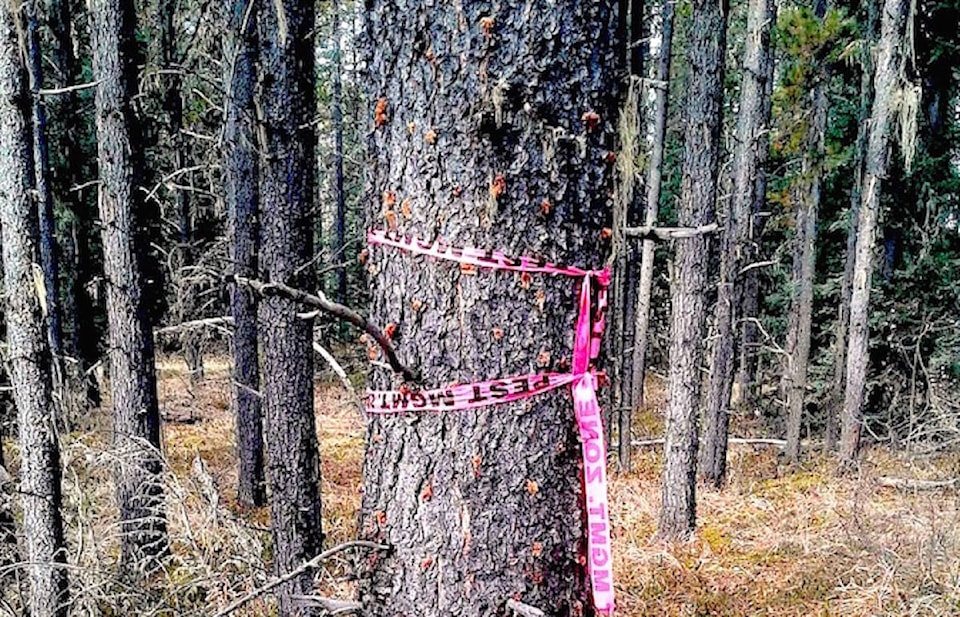For the first time ever, tree-killing mountain pine beetles have been found in forests just outside Rocky Mountain House.
“They are like an invading army, waiting at our borders,” said Gary Lewis, landcare supervisor for Clearwater County. Only the voracious beetles, which have decimated B.C. forests before attacking those around Jasper, are not just skirting remote edges of the West Country anymore.
Mountain pine beetles were found in trees just a kilometre from the Town of Rocky, said Pam Melnick, forest health officer for the Rocky district.
They were also discovered within Clearwater County in traps set by the Sundre branch of the logging company West Fraser.
Rocky Mayor Tammy Burke was apprised of the situation by local Alberta Forestry experts earlier this month. “So far there are no infected trees in town, but we’re keeping watch for them,” said Burke.
Having seen Jasper’s dead pine forests “we’re obviously very concerned,” Burke added. “If this goes unchecked, it can sweep across our natural areas … and we don’t want to hike through brown, dead forests …”
Lewis said public information workshops are planned in the county in February to make landowners aware of what signs of beetle infestation to look for and report, so the affected trees can be cut down and burned.
Property owners should look for small bumps of tree sap, resembling the eraser end of pencils, pushed out along infected pine tree trunks. This occurs when the tree is attempting to expel the invading beetles, said Melnick.
A more obvious sign is when a green pine tree dies and turns red in the spring.
Landowners should call their municipality if they suspect they have found beetle-ridden trees on private property, or call Alberta Agriculture and Forestry if they find them on public property, Melnick advised.
She admitted the insects are nearly impossible to stop because they spend all but two weeks of their life cycle hiding inside trees. Burning affected tree strands is the only way humans have of slowing the beetle’s progress, Melnick added.
Historically, Mother Nature has been able to keep beetle populations in check with winter-time freezes of -36 C for prolonged periods. But with global warming, winters just don’t get that cold anymore, said Tom Daniels, Sundre forestry superintendent for West Fraser.
He added more temperate winters are resulting in flourishing beetle populations.
Melnick sees a bright spot in the unusual cold snap of September. She believes it slowed the pine beetles’ progression. Although temperatures didn’t dip to the point of killing adult beetles and large larvae, there are indications it was cold enough to have dented the population at the egg or small larvae stage, explains Melnick.
“Now all we need is another cold snap next spring.”
West Fraser’s Sundre operation has been rushing to cut down dead trees before they completely rot, so the company can at least get a reduced price for the stained lumber, said Daniels.
Finding these insects in the Rocky area is of great concern, added Daniels, who noted many B.C. logging companies that assumed they would be around “forever’” to log renewable forests, were driven out of business by the pine beetle.
Although the insects mostly kill mature trees, leaving younger ones to keep growing, Daniels said it would be a long wait to harvest these smaller trees. Alberta logging companies need 90-year-old forests to get the width of timber needed for the construction market.
Melnick doesn’t believe the impact on Alberta will be as great as on B.C. because there are more spruce and fir trees here, which aren’t on the beetles’ menu.
However, Daniels said the insects are now working their way into Northern Alberta’s jack pine forests, which, to his knowledge, have never had a pine beetle infestation before.
More information is available at https://www.agric.gov.ab.ca/app21/forestrypage?cat1
